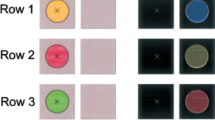Abstract
Colours are as objective as shapes. Representationalism about perceptual experiences – the view that perceptual experiences represent that things are thus and so, and that their doing so is at least part of what makes them the kinds of experiences they are – tells us this, and also how to defend the position against the most potent objection to it, the argument from the variability of colour vision.
Similar content being viewed by others
Notes
It is no news that things get quite a bit more complicated if we widen the net. My belief is that the key points urged here survive the complications.
For just one example, Tye (2000).
See, e. g., Hardin (1988).
What matters for the argument to come is that there are such animals, something which is common ground, not which they might be. I talk of shrimps in what follows. On whether or not they are a good example, see Thoen et al. (2014).
See, e. g., Tye (2006) and the references therein.
A version of this wrong way can be found in Jackson and Pargetter (1987).
The details are controversial but they are not crucial for our purposes. What’s crucial is that there is some physical explanation or other – physical in the sense of being framed in terms of the kinds of properties physicists and neuroscientists talk about when plying their trades.
One of the leading supporters of the thesis that perceptual experiences represent belongs to this camp. See Peacocke (2002).
As it happens, this is not the view I favour about the example. When the experiences differ, the representational content of one of the experiences will be more determinate concerning the space between the top of the liquid and the top of the glass, and the content of the other experience will be more determinate concerning the distance between the top of the liquid and the bottom of the glass. Hence, how the experiences represent things to be won’t be quite the same, but no matter here.
Cf. Wittgenstein (1963, §610). ‘Describe the aroma of coffee. – Why can’t it be done? Do we lack the words?’
Many have said things like this, as you would expect if it articulates the nature of experiences familiar to everyone with colour vision. See especially Harrison (1967), who uses the idea as the basis for a description theory of reference for colour words.
Were this an essay on colour words instead of the metaphysics of colour, I would argue that colour words refer to the role properties and not the realiser properties, which would be, I take it, a point of disagreement with Harrison (1967).
We could of course imagine that the machine spits out number triples if we wished to make it more like the colour case.
References
Armstrong, D. M. (1968). A materialist theory of the mind. London: Routledge & Kegan Paul.
Hardin, C. L. (1988). Color for philosophers: Unweaving the rainbow. Indianapolis: Hackett.
Harman, G. (1990). The intrinsic quality of experience. In J. Tomberlin (Ed.), Philosophical perspectives, 4, action theory and philosophy of mind (pp. 31–52). Atascadero: Ridgeview Press.
Harrison, B. (1967). On describing the colours. Inquiry, 10, 38–52.
Hazen, A. P. (1999). On naming the colours. Australasian Journal of Philosophy, 77, 224–231.
Jackson, F., & Pargetter, R. (1987). An objectivist's guide to subjectivism about colour. Revue Internationale de Philosophie, 41(160), 127–141.
Moore, G. E. (1903). The refutation of idealism. Mind, 12, 433–453.
Peacocke, C. (2002). Sensation and the content of experience: A distinction. Reprinted in David J. Chalmers (Ed.), The philosophy of mind (pp. 435–446). New York: Oxford University Press.
Smith, M. (1998). Response dependence without reduction. European Review of Philosophy, 3, 85–108.
Thoen, H., How, M., Chiou, T.-H., & Marshall, J. (2014). A different form of colour vision in mantis shrimp. Science, 343(6169), 411–413.
Tye, M. (2000). Consciousness, color, and content. Cambridge: MIT Press.
Tye, M. (2006). The puzzle of true blue. Analysis, 66(291), 173–178.
Wittgenstein, L. (1963). Philosophical investigations. Oxford: Basil Blackwell.
Acknowledgments
Thanks to the many who have discussed these issues with me over the years and to a reviewer. The positive proposal I make was suggested to me by some remarks in Armstrong (1968, around p. 275) but I am all but certain he would dissent from the use I make of them.
Author information
Authors and Affiliations
Corresponding author
Rights and permissions
About this article
Cite this article
Jackson, F. How to be an objectivist about colour. Phenom Cogn Sci 18, 819–831 (2019). https://doi.org/10.1007/s11097-017-9551-x
Published:
Issue Date:
DOI: https://doi.org/10.1007/s11097-017-9551-x



